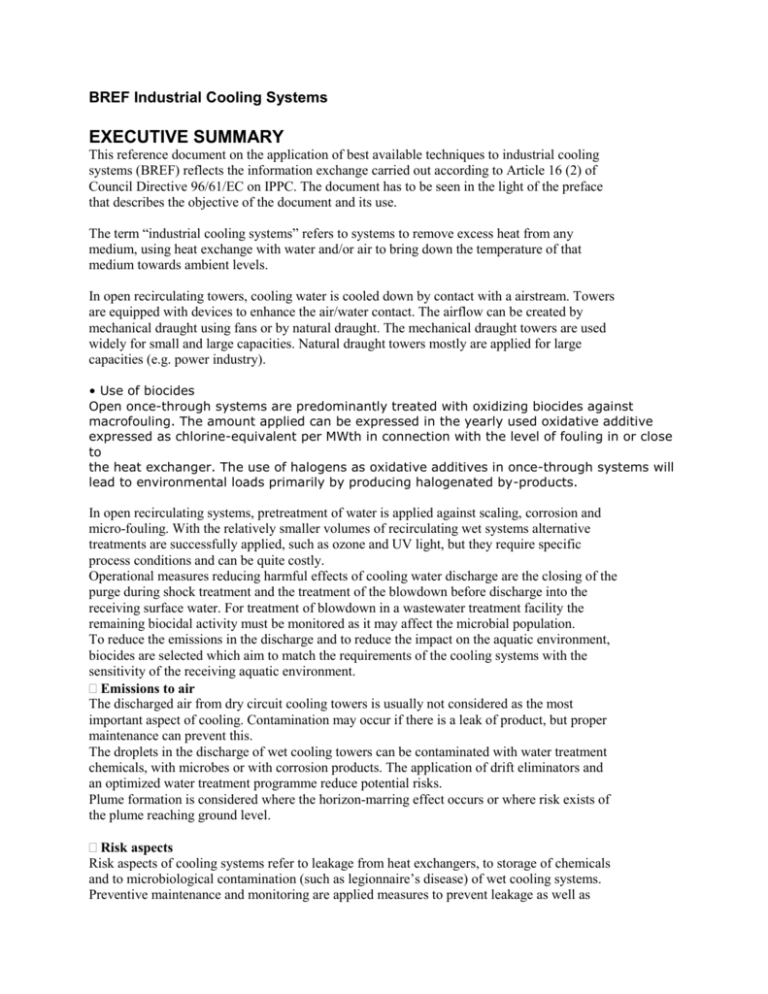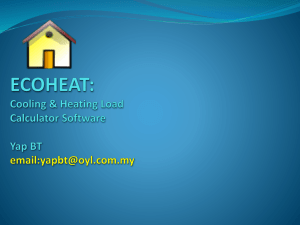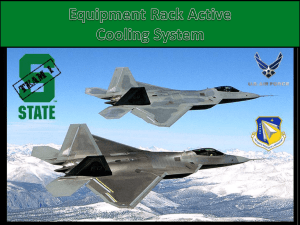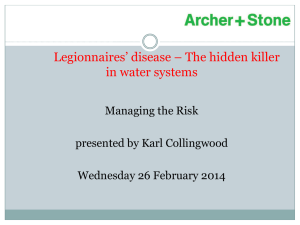BREF Industrial Cooling Systems
advertisement

BREF Industrial Cooling Systems EXECUTIVE SUMMARY This reference document on the application of best available techniques to industrial cooling systems (BREF) reflects the information exchange carried out according to Article 16 (2) of Council Directive 96/61/EC on IPPC. The document has to be seen in the light of the preface that describes the objective of the document and its use. The term “industrial cooling systems” refers to systems to remove excess heat from any medium, using heat exchange with water and/or air to bring down the temperature of that medium towards ambient levels. In open recirculating towers, cooling water is cooled down by contact with a airstream. Towers are equipped with devices to enhance the air/water contact. The airflow can be created by mechanical draught using fans or by natural draught. The mechanical draught towers are used widely for small and large capacities. Natural draught towers mostly are applied for large capacities (e.g. power industry). • Use of biocides Open once-through systems are predominantly treated with oxidizing biocides against macrofouling. The amount applied can be expressed in the yearly used oxidative additive expressed as chlorine-equivalent per MWth in connection with the level of fouling in or close to the heat exchanger. The use of halogens as oxidative additives in once-through systems will lead to environmental loads primarily by producing halogenated by-products. In open recirculating systems, pretreatment of water is applied against scaling, corrosion and micro-fouling. With the relatively smaller volumes of recirculating wet systems alternative treatments are successfully applied, such as ozone and UV light, but they require specific process conditions and can be quite costly. Operational measures reducing harmful effects of cooling water discharge are the closing of the purge during shock treatment and the treatment of the blowdown before discharge into the receiving surface water. For treatment of blowdown in a wastewater treatment facility the remaining biocidal activity must be monitored as it may affect the microbial population. To reduce the emissions in the discharge and to reduce the impact on the aquatic environment, biocides are selected which aim to match the requirements of the cooling systems with the sensitivity of the receiving aquatic environment. Emissions to air The discharged air from dry circuit cooling towers is usually not considered as the most important aspect of cooling. Contamination may occur if there is a leak of product, but proper maintenance can prevent this. The droplets in the discharge of wet cooling towers can be contaminated with water treatment chemicals, with microbes or with corrosion products. The application of drift eliminators and an optimized water treatment programme reduce potential risks. Plume formation is considered where the horizon-marring effect occurs or where risk exists of the plume reaching ground level. Risk aspects Risk aspects of cooling systems refer to leakage from heat exchangers, to storage of chemicals and to microbiological contamination (such as legionnaire’s disease) of wet cooling systems. Preventive maintenance and monitoring are applied measures to prevent leakage as well as microbiological contamination. Where leakage could lead to discharges of large amounts of substances harmful to the aquatic environment, indirect cooling systems or special preventive measures are considered. For prevention of the development of Legionellae pneumophila (Lp) an adequate water treatment programme is advised. No upper concentration limits for Lp, measured in colony forming units [CFU per liter], could be established below which no risk is to be expected. This risk has to be particularly addressed during maintenance operations. Reduction of leakage and microbiological risk BAT are: preventing leakage by design; by operating within the design limits and by regular inspection of the cooling system. For the chemical industry in particular, it is considered BAT to apply the safety concept of VCI as has been mentioned before for reduction of emissions to water. The occurrence in a cooling system of Legionella pneumophila cannot be fully prevented. It is considered BAT to apply the following measures: - avoid stagnant zones and keep sufficient water velocity, - optimize cooling water treatment to reduce fouling, algae and amoeba growth and proliferation, - apply periodic cleaning of the cooling tower basin and - reduce respiratory vulnerability of operators by supplying noise and mouth protection when entering an operating unit or when high-pressure cleaning the tower. Industrial Cooling Systems 3.7.3 Microbiological risk 3.7.3.1 Occurrence of microbes Microbiological risks from cooling systems relate to the occurrence of different species of pathogens in cooling water or in parts of the system that are in contact with the cooling water, such as biofilms in heat exchangers and fill in cooling towers. These risks are not an issue in dry cooling systems. Blz 113 the bacteria Legionella pneumophila (Lp) and the amoeba Naegleria fowleri (Nf). In marine waters some halophilic vibrios species, pathogenic for fish or man, can develop in once-through cooling systems. The species mentioned occur in the natural environment in generally low and harmless concentrations. Due to the raised temperature a favourable climate can occur in cooling systems enhancing the development of those bacteria, which can create a potential risk for human health. Development of Legionella is enhanced by fouling, presence of amoeba, ciliates and algae. It is spread through aerosols. Following some large outbreaks the occurrence and characteristics of Legionnaire’s disease (LD) and the development of Lp has been widely researched from a medical/biological point of view. But many points relating to the chemical and process technology remain unclear. In the plume of a natural draught wet cooling tower with a considerable height and with a good functioning drift eliminator, the emission of bacteria is of less importance, but not impossible. A high concentration of Lp in the plume of a natural draught wet cooling tower has been reported due to fouling on the inside of the concrete cooling tower wall. The layer had been released from the wall and fallen onto the drift eliminator [tm145, Werner and Pietsch, 1991]. The appearance of Lp in the plume of industrial mechanical draught cooling towers, which have a much lower height than natural draught towers, has been reported on a number of occasions [tm040, Schulze-Robbecke and Richter, 1994], but a clear cause and effect relation between cooling towers and an LD outbreak could not be established. Where a relation between cooling systems and an outbreak of LD could be made it always concerned badly maintained systems [Morton et al., 1986]. Typical conditions in wet cooling towers that enhance the development of Legionella are: the water temperature in the cooling tower is between 25 and 50 degrees centigrade; the pH between 6 and 8; the presence of fouling. Less information was submitted on the occurrence and treatment of other pathogens such as Nf. It has been observed that development of Nf is inhibited by brass and enhanced by stainless steel. The amoebae are also more abundant in open recirculating cooling systems than in oncethrough cooling systems. Research was carried out on the treatment of Nf after increased levels in plant cooling water (3000 1-1) followed replacement of condensers in a French power station. Continuous chlorination with a maximum free residual chlorine level in the range of 0.3-0.5 mg/l decreased concentrations of Nf immediately and the levels remained under 4 pathogens/l. [tm 144, Cabanes et al, 1997]. 3.7.3.2 Measuring of bacteriae Lp-bacteria are measured in colony forming units or CFU per litre and are reported to vary in concentration in cooling tower water from very low (down to 10 CFU/l) to very high (105-106 CFU/l). In biofilms Lp has been found in concentrations of up to 106 CFU/cm2. For air conditioning systems, values of 100-1000 CFU are applied in the UK, but it is not clear if this can be compared to the levels in well-maintained wet cooling towers and the associated risk in those situations. A recommendation was made to keep the concentration of Lp below 104 CFU/l. Quantification of representative concentrations of Lp in industrial wet cooling systems and the level of CFU in wet cooling towers that is still acceptable with respect to human health may require further research. 3.7.3.3 Techniques to reduce microbiological risks ([038, Millar et al., 1997] and [tm040, Schulze-Robbecke and Richter, 1994], [tm166, Morton et al, 1986] [tm167, Fliermans, 1996], ) The chain of events to create an outbreak of Legionella involves: Blz 114 - the development of a virulent strain of bacteria in the cooling system - conditions that enhance the multiplication of bacteria - contaminated water discharged to the atmosphere as aerosol - sufficient droplets deeply inhaled by susceptible persons Prevention of Legionella should therefore be based on prevention of development and multiplication of bacteria in the cooling system. Particularly in the USA and UK recommendations have been developed for prevention of LD. Regular analysis of the potential reservoir (e.g. cooling tower), and additional routine maintenance, proper pH and temperature levels, adequate levels of residual biocides, and control on quality of the makeup water can prevent the occurrence of environments that encourage Legionella. On the prevention of formation of Lp-bacteria (and others) in cooling towers, the following measures should be applied: use clean water and pretreat the cooling water if possible; avoid process leakage into the cooling system; avoid stagnant zones; prevent formation by reduction of light energy within the cooling tower avoiding algae formation; open water basins are to be avoided; easy access for regular cleaning should be provided; use of drift eliminators that can be easily cleaned or replaced; design cold water temperature as low as possible (small approaches); avoid scale and corrosion; optimisation of construction to enhance the right water velocity and air speed; a minimum distance of the CT from populated areas is impossible to give, but consideration should be given to avoiding the plume reaching ground level or reaching populated areas, if space allows; minimisation of plume formation could restrict the spread. With respect to the location of a cooling tower a rating has been suggested of the microbiological risk associated with a cooling tower based on the host population and the potential susceptibility of the host. The rating categories are: - Category 1: highest risk – cooling tower serving or in the vicinity (<200 m) of a hospital, nursing home or other health care facility caring for persons who may be immunologically compromised; - Category 2: cooling tower serving or in the vicinity (>200 m) of a retirement community, hotel or other buildings accommodating a large number of people are localised; - Category 3: cooling tower in a residential or industrial neighbourhood; - Category 4: lowest risk – cooling tower isolated from residential neighbourhood (>600 m from residential area). Based on this rating, inspection for the presence of Legionella ranges from monthly (highest risk), monthly to quarterly (Cat. 2), quarterly to yearly (Cat. 3) to once a year after summer (Cat. 4). The following measures are recommended to operators of cooling towers: care must be taken in case of process stops and start-ups, especially if the cooling circulation system is down for more than 4 days; operators entering cooling towers should avoid inhaling the air by using mouth and nose protection (P3-mask has been proven); If cleaning a cooling system after Lp has been detected, a combination of mechanical cleaning and a shock-dosage of a biocide. Blz 115 Some additional remarks on these recommendations can be made. After a prolonged shutdown it is imperative to treat cooling systems with a biocide (chlorine). If there is evidence of a dirty or contaminated system, including accessories such as sound attenuation, it must be cleaned and receive biocide shock treatment prior to start-up. A competent water treatment company should conduct such treatment. Disinfection of the system may be needed if the system is heavily contaminated. From experience it is clear that chemical treatment mainly treats the bacteria in the water. To control and clean the cooling system more thoroughly attention must be paid to sediments and fouling on the cooling system surface, hence the importance of mechanical cleaning. The level of free chlorine of 50 mg/l mentioned in the literature is clearly a shock dosage level that has been applied after an outbreak of LD. Because of the large amount of hypochlorite involved, it is clear that this treatment is not appropriate as maintenance level in a cooling tower. In any case, after shock dosing, detoxification of the treated cooling water would be necessary before discharge and treatment with bisulphite has been commonly applied. A high maintenance level to prevent Lp-development as much as possible is to be favoured. In general, oxidising biocides are favoured for killing the Legionella in the water. Slower acting agents are needed to attack bacteria in the biofilms. This would then require treatment with nonoxidising biocides. Of these the QACs have shown better results than the isothiozolines. In a recent Dutch report [tm155, Berbee, 1999] some results on reducing the CFU-level in cooling towers were reported which confirmed that a clear minimum concentration level of biocides has not yet determined. It was concluded that high levels of biocide were needed to reduce-concentrations, but only showed a temporary effect. The side effect of elevated levels of toxic by-products must be realised. Lower water temperature appeared to be more effective than application of biocides (Table 3.14), but this may not be applicable in every case. Investigations into the effect of treatment of the protozoa revealed that very high concentrations are needed to kill the protozoa and that cysts are hardly susceptible to the applied non-oxidising biocides. Blz 116 (minus tabel met effecten van dosering met PHMB: polyhexamethylenebiguanidechloride (QAC) en BNPD: bromonitropropaandiol)






